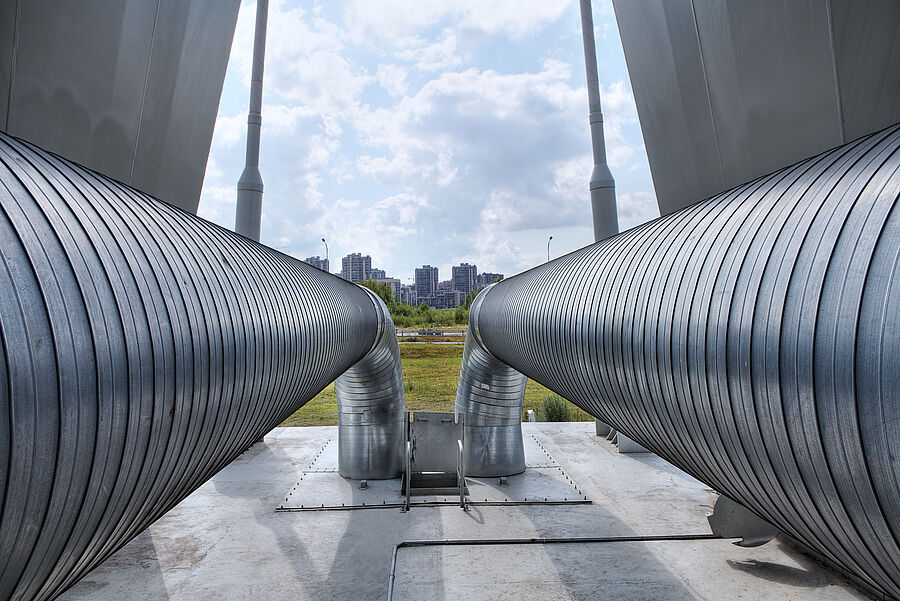HEATROCK - Thermal energy storage in crystalline rocks
Heating networks are a key component of the energy transition, as almost half of final energy consumption in Austria is in the form of thermal energy. The increased use of renewable energies is increasingly leading to temporal and spatial discrepancies between energy supply and heat demand. It is therefore crucial to drive forward the decoupling of energy generation, consumption and storage.
Large heat storage facilities play a key role in the efficient use of climate-neutral waste heat and energy and in the expansion of district heating networks. They enable existing resources to be stored and used for weeks or even months at a time. Seasonal thermal energy storage systems in particular can significantly support the heat transition by making energy generated in summer or industrial waste heat available for use in the winter months.
In urban areas, however, high land prices, limited land resources and dense development pose challenges for the construction of large, visible storage facilities. In addition, a lack of social acceptance can also be a significant obstacle.
The technology of large-scale seasonal heat storage systems, especially underground storage tanks, has already reached an advanced stage of development. Numerous examples have been implemented in Denmark and Germany, particularly in rural areas or smaller neighborhoods. Interest in the use of this technology is also steadily increasing. However, underground storage tanks have some disadvantages, such as limited storage capacity and comparatively high construction costs, especially under the conditions in Austria.
A promising alternative to underground reservoirs is the use of caverns in solid rock as large-scale thermal energy storage facilities (Cavern Thermal Energy Storages, CTES). Austria offers many potential locations for such cavern storage facilities, often close to urban centers. These storage facilities are characterized by an extremely long service life and almost invisible integration into the environment.
However, cavern storage facilities differ technologically from both underground storage facilities and conventional tunnel construction projects, which brings with it specific requirements and opportunities for their implementation.
Project goals
The HEATROCK project pursues two central objectives: to further develop the technology of optimized cavern storage for seasonal balancing in urban district heating networks from technology readiness level (TRL) 2 to TRL 4 and to reduce the specific investment costs for cavern storage.
This technological research project aims to establish Austrian research institutions, public companies and technology providers as pioneers in the field of heat storage in geological caverns. This will create a significant innovation impulse for the heat transition in Austria, which will also contribute to achieving climate neutrality - both at national level and beyond.
Detailed project goals:
- Development of cavern storage technology,
- Cost-effective cavern storage solutions,
- Development of insulation and sealing methods,
- Improved planning methods,
- Improved simulation models and digital twins for optimized design, planning and operation.
Further development of cavern storage systems
The current state of the art in cavern storage technology involves the use of advanced materials and innovative design approaches aimed at storing thermal energy with minimal losses and releasing it efficiently when required. Important elements here are
- Sealing materials: Robust and reliable sealing materials are essential to prevent leaks and ensure the long-term integrity of the storage system.
- Highly efficient insulation materials: These minimize heat loss and make a decisive contribution to overall energy efficiency.
- Intelligent control systems: Such systems optimize heat output based on current demand, improving operational efficiency.
- Efficient heat exchangers: These ensure effective transfer of thermal energy between the storage medium and the heat supply system.
- Monitoring and safety systems: These systems enable continuous monitoring of the storage operation and ensure a high level of operational safety.
- Integration of renewable energies and waste heat sources: The use of renewable energy sources and industrial waste heat can make the storage process more sustainable and increase overall efficiency.
Together, these technologies form the basis for the further development of modern cavern storage systems and their integration into future-oriented heating networks.
The AIT plays a central role in the FFG-funded HEATROCK project, which aims to improve the efficiency and sustainability of seasonal thermal energy storage systems. As the leader of work packages 6 and 7 (WP6 and WP7), AIT is responsible for several important tasks:
- Simulation models and digital twins: digital simulations and virtual models make it possible to accurately predict the performance of storage systems, leading to better planning and optimized operation,
- Development of charging and discharging methods and devices: AIT is working on innovative approaches to make the processes of storing and loading/unloading thermal energy more efficient and effective,
- Characterization and application of insulation and sealing materials: This includes the identification and use of optimal materials that contribute to improving energy efficiency and reducing costs in energy storage systems,
- Techno-economic analyses: In order to assess the technical and economic feasibility of the storage systems, AIT carries out detailed analyses, identifies potentials and risks and develops strategies to maximize the system benefits,
- Multipliability: AIT will contribute to the multipliability of this research project so that the results, findings and methods for heat storage in caverns can also be applied and transferred to other energy suppliers, municipal utilities, etc. in other regions, countries and continents.



